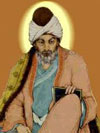 |
Attar 1119 -1220 . Attar was one of the most ancient and highly revered poets of Persia. He inspired later Sufi poets, such as Rumi and Hafiz |
Farid od Din Attar was born in Nishapur and lived about 1119-1220 (Another source mentions he lived about 1136-1230). He lived close to 100 years and was killed by the Mongol invaders. His tomb is in Nishapur. During his lifetime he wrote mystical poetry writing of man’s ultimate relationship with the Divine reality.
And as His Essence all the world pervades
Naught in Creation is, save this alone.
Upon the waters has He fixed His Throne,
This earth suspended in the starry space,
Yet what are seas and what is air? For all
Is God.
– Attar (excerpt from All Pervading Consciousness)
Different stories are told about the death of Attar. One common story is as follow: He was captured by a Mongol. One day someone came along and offered a thousand pieces of silver for him. Attar told the Mongol not to sell him for that price since the price was not right. The Mongol accepted Attar’s words and did not sell him. Later someone else comes along and offers a sack of straw for him. Attar counsels the Mongol to sell him because that is how much he is worth. The Mongol soldier becomes very angry and cuts off Attar’s head so he dies to teach a lesson.
Attar is one of the most ancient poets of Persia. His work has been the inspiration of Rumi and many other mystic poets of Persian Empire. Rumi considered Attar the spirit and Sanai the eyesight , both of whom his poetic masters. Attar met Rumi at the end of his life when Rumi was only a boy and gave his book Asrarnameh as a present to him.
Attar took his name from his occupation. He was a druggist, perfumist and a doctor in addition to being a poet. Attar saw as many as 500 patients a day in his shop where he prescribed herbal extractions/medicine which he made himself.
In his shop, he also wrote while seeing patients. Attar wrote 114 pieces, the same number of suras in the holy book of Koran. About thirty of his works survived. To name a few of his works are love stories, biographies of saints, Asrarnameh (“The Book of Secrets”), a collection of quatrains, Illahinameh (“The Book of God”) and the last not the least, his most well known masterpiece of Mantiq at-Tayr (“The Bird of the Sky”) known as “The Conference of the Birds”
In The Book of God, he describes six human capacities and abilities: ego, imagination, intellect, thirst for knowledge, thirst for detachment, and thirst for unity. In The book of Secrets, he uses a collection of small stories to elevate the spiritual state of the reader.
In “The Conference of the Birds,” Attar explains seven valleys (veils) which the “Bird of the Sky” goes through and passes to meet Simurgh (God). This is a process that each of us goes through. What we make of ourselves and what we become, good or bad, happy or unhappy, satisfied or dissatisfied, we do ourselves.
Poems by Attar
- All Pervading Consciousness
- In the Dead of night
- Intoxicated by the Wine of Love
- Invocation
- Looking for your own face
- Mystic Silence
- The Triumph of the Soul
- Why was Adam
Links
